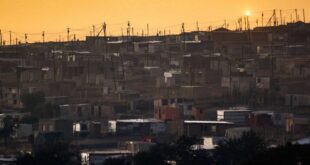One year ago, an early manifestation of opposition by the working class to the homicidal response of the ruling class to the COVID-19 pandemic began with a series of wildcat strikes in Italy. Over the next week, strikes spread to other European countries and to North and South America.
At the time, the deadly disease was surging in northern Italy and cases were rising in the US and around the world. Italian Prime Minister Giuseppe Conte resisted any emergency measures, even as the death toll approached 500.
Conte would soon be deploying Army trucks to transport the dead in Bergamo to crematoriums. On March 9, he finally announced a partial national lockdown. However, bowing to the demands of the major industrialists’ association, Confindustria, Conte allowed factories and other large workplaces to remain open.
The strike wave began the following day, on Tuesday, March 10, when thousands of autoworkers at Fiat Chrysler’s Pomigliano plant in Naples, forced to stay on the line to produce luxury Alfa-Romeo cars, walked out spontaneously to protest unsafe conditions.
The following day, Wednesday, March 11, FCA announced the temporary closure of the Pomigliano plant, along with factories in Melfi, Atessa and Cassino. Management made it clear, however, that production would resume by March 14 after the plants had been “sanitized.”
Over the next three days, wildcat strikes spread across Italy–to the steel mills in Bergamo, Brescia and Genoa; the Liguria shipyards and the Electrolux factory in Treviso; car parts plants in Cormano; Amazon warehouses in the provinces of Piacenza and Rieti, and the poultry and meat processing facilities in the Po Valley.
“The workers are striking against the coronavirus, or rather against the government that is keeping the factories open despite the coronavirus,” wrote the Corriere della Sera.
The opposition of workers quickly spread internationally. On Thursday, March 12, Royal Mail workers walked out at several London facilities over safety conditions. Across the Atlantic in Canada, Fiat Chrysler workers at the Windsor, Ontario plant halted production the same day that FCA management acknowledged the first COVID-19 case at a North American plant, a facility in Indiana. Production was resumed the following day only after the intervention of the Ontario labour minister and the Unifor union.
As in Italy and the UK, the action by workers in Canada and the United States would take the form of a rebellion against the trade unions, which kept workers in the plants despite the spread of the deadly disease.
While the United Auto Workers sent its top staff home to work remotely, the UAW warned workers against “spreading rumors” about outbreaks in the plants and instructed them to wash their hands and “avoid contact with others within two to three feet, if possible.” Workers laboring shoulder-to-shoulder inside the factories denounced these statements with contempt, with one Indiana worker saying that both the UAW and the company “don’t give a damn about any one of us or our families.”
By Monday, March 16, Warren Truck Assembly Plant workers in suburban Detroit downed their tools in the paint shop, where at least four workers would die from the disease. Earlier the same day, 5,000 workers at the Vitoria Mercedes-Benz plant in the Basque Country, Spain walked out against unsafe conditions.
On Tuesday, March 17, FCA Transmission workers in Tipton, Indiana, just outside Kokomo, refused to operate their machines, along with Lear seating workers in Hammond, Indiana. The same day, Detroit bus drivers conducted a sickout. Thst evening, the UAW announced it had a deal with the Big Three automakers for rolling temporary closures. Having no faith in the UAW, a few hours later workers at Sterling Heights Assembly Plant (SHAP) in suburban Detroit—one of the largest auto plants in the US—halted production.
By Wednesday, March 18, the morning shift at SHAP was continuing the job action and was joined by workers at the Jefferson North Assembly Plant in Detroit, the Dundee Engine Plant near Ann Arbor, Michigan, and the Toledo Assembly Complex in Ohio, where rank-and-file workers stormed into the UAW offices to denounce the union officials. In the early afternoon, the Big Three automakers announced the closure of their plants, claiming this had been done out of concern on the part of the companies and the UAW for the safety of the workers.
The following day, Thursday March 19, wildcat strikes erupted at call centers across Brazil, with workers at Italian-owned ImaViva declaring, “We are not going to die in our cubicles!” The strike occurred three days after the company’s 2,800 workers in Palermo, Italy struck after a confirmed case of COVID-19, forcing the closure of in-person operations.
There were a number of significant aspects to this wave of struggles. First was its global character. The pandemic is an inherently global crisis, and the COVID-19 virus did not and does not respect international boundaries. Workers throughout Europe and the Americas were responding in an effort to save lives over the profit interests of the corporate and financial elites.
Second, these struggles were emerging when the pandemic was still in its early stages. On March 10, the worldwide death toll from the pandemic stood at about 6,500. By the end of March, it had risen sharply to 45,000. In the US, the first recorded death came at the very end of February, and the wildcat strikes at auto plants broke out as the national toll approached 100.
One year later, the global death toll stands at a staggering 2.6 million people, including more than 538,000 in the United States alone.
Third, while the corporate-owned news media did everything it could to black out reports of the spreading resistance of workers, the World Socialist Web Site provided detailed accounts of the strike wave. But we did not only report on these struggles. The WSWS and the Socialist Equality Parties around the world actively encouraged workers to take the independent initiative to save lives. The SEP (US) statement, of March 14, “Shut down the auto industry to halt the spread of coronavirus!” was viewed over 130,000 times.
The initial action of the working class—which in the US included 260 strikes and job actions triggered by the pandemic and involving a wide variety of workers between March 1 and May 31—forced the partial lockdowns of businesses and schools, saving countless lives.
These actions were of immense significance, but they remained largely uncoordinated. While workers were striving to impose a policy that would save lives, they were not led by a network of independent workers’ organizations or guided by a clear political perspective and program.
The ruling class responded by going on the offensive. In late March, the US Congress, with the near unanimous support of Republicans and Democrats, passed the CARES Act, which financed an estimated $4 trillion handout to Wall Street and major corporations. The limited financial assistance to workers included in the CARES Act was used to buy the ruling class time to embark on a systematic campaign to reopen the schools and workplaces, with the support of the unions, based on the slogan that “the cure can’t be worse than the disease.”
This was accompanied by the promotion of fascistic forces demanding an end to lockdowns, including the April 30 storming of the Michigan state capitol by armed right-wing militias, a dress rehearsal for the January 6 coup attempt in Washington D.C.
Amidst these developments, the World Socialist Web Site and the Socialist Equality Parties throughout the world advanced a program to stop the pandemic. On February 28, when the death toll was just 3,000, the International Committee of the Fourth International issued a statement calling for a “globally coordinated emergency response to the coronavirus pandemic,” including the mobilization of the social and scientific resources of the entire world to stop the disease.
On March 17, when the US death toll was 170, the National Committee of the SEP (US) published a statement titled, “How to fight the COVID-19 pandemic: A program of action for the working class.” It called for “the immediate closure of all schools, non-essential plants and other workplaces, with full income for workers affected: No worker should be expected to place his or her life in danger.”
It is an undeniable fact that if the policies advanced by the International Committee of the Fourth International had been implemented, hundreds of thousands, even millions of lives would have been saved.
One year later, the working class is at a crossroads. All over the world, remaining restrictions are being lifted. Boris Johnson reopened schools in the UK on Monday. Tens of thousands of teachers and students, including high school students in New York City, are being herded back to school by the Biden administration and with the backing of the corporatist unions, even as experts warn of a “hurricane” surge of the pandemic over the next four to six weeks.
The working class must forge a new political leadership and build rank-and-file committees, independent of the unions, to prepare strike action to close schools and all non-essential production, and demand full compensation for workers and small businesses until the population is widely vaccinated and the pandemic is under control.
The must be combined with the fight for a socialist program, including the expropriation of the pandemic profiteers, a radical redistribution of wealth and massive infusion of resources needed for testing, contact tracing, vaccination, and other health care measures necessary to wipe out COVID-19.
Source link


